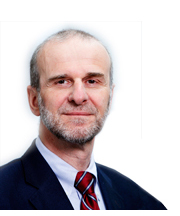When Manfred Morari looks back over the 35 years of his career, he will tell you that his graduate school years, spent under his advisor George Stephanopoulos at the University of Minnesota (now at MIT), still stand out. The most important thing he learned, he says, was how to formulate problems. "It was a continuous dialogue with my advisor to arrive at those problems worth solving." Since then, he has solved many. The proof is in his expansive collection of published papers, which have placed him among the most highly cited researchers.
Manfred specializes in hybrid systems analysis and control. The techniques emerging from his research have applications to diverse industrial challenges, such as those that arise in automotive systems, biomedical engineering, efficient energy use, and active noise control. These days, though, Manfred works not only as a researcher but also as a leading administrator. He heads the Department of Information Technology and Electrical Engineering at The Swiss Federal Institute of Technology Zurich, known by its German acronym as ETH.
Manfred moved to ETH in 1994, coming from his professorship at California Institute of Technology. It was ultimately a transition from chemical engineering to electrical. He and his group found themselves tasked with taking methods developed for slow, complex chemical systems, and extending them to fast electrical processes. A new fast variety of a control algorithm for dynamic systems called Model Predictive Control emerged from this challenge. After a decade of study and computation, "We have now learned how to apply those techniques to processes that are not reacting in tens of minutes, but in microseconds."
Manfred sees his approach at ETH as a balance between three pillars: theory, computation, and application – a similar approach to the one taken by LIDS researchers. However, LIDS and ETH differ in the level of focus on applications. At ETH, active collaborations with companies such as Ford and Siemens allow new algorithms to be tested on real developing technologies, some of which have already reached the market. For example, Daimler and Ford use an electronic stability program, or traction control system, features of which were contributed by Manfred's group.
Currently, Manfred is involved in the algorithmic design of efficient energy technologies for buildings. The goal is to reduce overall energy consumption and peak electricity load while improving occupant comfort. They've designed a system that monitors electricity prices and determines when it is most cost effective to heat. But the weather also affects heating and cooling needs. So, ETH's design goes a step further. The control system takes weather forecasts and shifting electricity prices into account to calculate, for example, whether a building should use more electricity in the morning, afternoon, or night.
Manfred says that the application of his computations to buildings would simply not be possible without collaboration with industry. "It's a fantastic opportunity that very few people in academia have to apply their research results on full scale to see what the benefits and difficulties will be," he says. They suspect, however, that even though it's easy to install new technology in new homes, it may take decades to implement it widely in old buildings.
Manfred is most excited about another project involving energy production. Many research groups worldwide are working on machinery that harvests wind energy through the controlled movement of high-altitude kites. By many estimates, kite systems have the potential to meet global demands at a cost lower than fossil fuels.
Outside of these projects, Manfred spends a great deal of time recruiting new faculty members to replace a large number of retiring professors. He enjoys seeing young people enter the field full of fresh ideas, plus the job keeps him in contact with MIT.
Pablo Parrilo has recently left ETH Zurich to join LIDS, while Vanessa Wood of MIT's Electrical Engineering and Computer Science Department joined ETH's faculty in January. Manfred says that he'll be stopping over at LIDS again soon, and not just because he is a member of LIDS' Advisory Committee. "If we can recruit another assistant professor, then I'll be delighted."
Overseeing this new generation has given Manfred a clear sense of how his field has evolved over the last 40 years. The changes are unmistakable: The world has become much more competitive and it is increasingly challenging to excel in the academic environment, Manfred observes. Part of the reason is the rapid growth of new areas like bioengineering and bioelectronics, a shift that's happening so fast that it's hard to keep up.
Researchers in Manfred's departments, however, have stepped up to this biomedical challenge. One group is developing special electrodes that measure electrical signals and reactions in nerve cells. New imaging methods are in the works, too. Other developments unheard of ten years ago include a "microsyringe" that allows researchers to inject DNA strands into single cells without using a genetic vector, as well as a process that samples the interior of a cell without destroying it. "This range of areas to which we can contribute is not limited to traditional electrical systems," says Manfred. His work is about applying innovative theoretical ideas to broad contexts, medical or environmental. Wind harvesting technology and microsyringes may be worlds apart, but they are united by the control systems operating within them.




